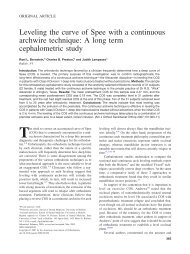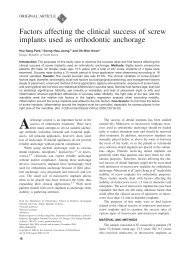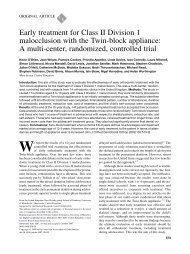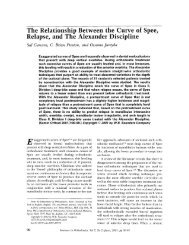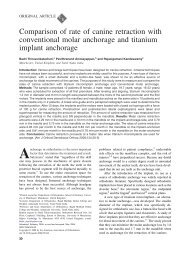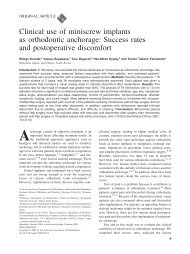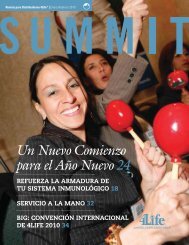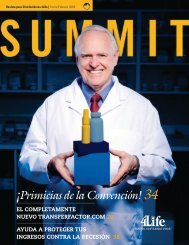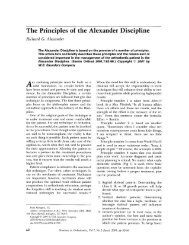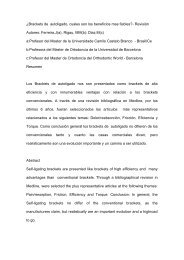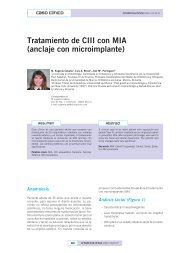Biomechanical and histological comparison of self-drilling and self ...
Biomechanical and histological comparison of self-drilling and self ...
Biomechanical and histological comparison of self-drilling and self ...
You also want an ePaper? Increase the reach of your titles
YUMPU automatically turns print PDFs into web optimized ePapers that Google loves.
American Journal <strong>of</strong> Orthodontics <strong>and</strong> Dent<strong>of</strong>acial Orthopedics<br />
Volume 133, Number 1<br />
surface <strong>of</strong> microimplants that is directly in contact with<br />
bone matrix <strong>and</strong> is calculated with s<strong>of</strong>tware <strong>and</strong> expressed<br />
as a percentage <strong>of</strong> the total microimplant surface. In this<br />
study, the mean BIC values in the SDI group were 39.28%<br />
in the maxilla <strong>and</strong> 47.44% in the m<strong>and</strong>ible. In the STI<br />
group, the mean BIC values were 27.96% <strong>and</strong> 26.35% in<br />
the maxilla <strong>and</strong> the m<strong>and</strong>ible, respectively. Because the<br />
BIC values were higher in the SDI group than in the STI<br />
group, this showed that the <strong>drilling</strong> method had an effect<br />
on bone-to-microimplant contact; this was further confirmed<br />
by PRT values <strong>and</strong> histologic findings <strong>of</strong> more<br />
original <strong>and</strong> new bone in the SDI group.<br />
BIC values <strong>of</strong> 93.8% in the SDS group <strong>and</strong> 81% in<br />
the STS group were found after 6 months <strong>of</strong> observation<br />
in pigs.<br />
19 Heidemann et al<br />
19 demonstrated that the<br />
BIC values in the SDS group were superior to those in<br />
the STS group because <strong>of</strong> the greater amount <strong>of</strong> original<br />
bone in the threads <strong>of</strong> the drill-free screws. Similarly, in<br />
21<br />
the study <strong>of</strong> Kim <strong>and</strong> Chang, the mean BIC value<br />
(43.68%) in the drill-free group was higher than in the<br />
drill group (23.41%) in dogs. Obviously, compared<br />
with previous studies, our results indicate that using<br />
SDIs without chemical <strong>and</strong> biologic modification<br />
caused less damage to bone, <strong>and</strong> the time <strong>of</strong> bone<br />
modeling <strong>and</strong> remodeling was reduced because the<br />
bone debris was transported <strong>and</strong> deposited on the bone<br />
surface around the implant tip because <strong>of</strong> the conical<br />
shaft.<br />
19<br />
Compared with the results <strong>of</strong> Heidemann et al, the<br />
BIC values in our study were lower. This difference<br />
could be an internal response <strong>of</strong> bone to the implant<br />
31<br />
time <strong>and</strong> the healing condition. Melsen <strong>and</strong> Costa<br />
observed BIC values <strong>of</strong> 10% to 58% after 6 months <strong>of</strong><br />
forcing without a healing period for miniscrews. They<br />
found that the BIC ratio increased with implantation<br />
time but was independent <strong>of</strong> the type <strong>of</strong> bone <strong>and</strong> the<br />
magnitude <strong>of</strong> force. Our results have elucidated the<br />
mechanism behind the behavior <strong>of</strong> cells on implant<br />
surfaces, <strong>and</strong> we report an increase in BIC contact by<br />
using different <strong>drilling</strong> methods.<br />
Because the numbers <strong>of</strong> dogs <strong>and</strong> microimplants<br />
were limited, this study might be regarded as a pilot.<br />
However, the results were unequivocal because the<br />
tested microimplants were placed symmetrically. Further<br />
studies with different force magnitudes after a<br />
short healing period are required for more discussion<br />
<strong>and</strong> definite results.<br />
CONCLUSIONS<br />
By comparing the biomechanical <strong>and</strong> histologic<br />
properties between SDIs <strong>and</strong> STIs, without a healing<br />
period, we found high success rates in both groups.<br />
Chen, Shin, <strong>and</strong> Kyung 49<br />
PIT, PRT, <strong>and</strong> BIC values were higher in the SDI group<br />
than in the STI group.<br />
We recommend using SDIs in the maxilla <strong>and</strong> the<br />
thin cortical bone areas <strong>of</strong> the m<strong>and</strong>ible because there is<br />
less damage <strong>and</strong> use <strong>of</strong> instruments. In areas <strong>of</strong> dense<br />
cortical bone, STIs <strong>and</strong> SDIs with larger diameters can<br />
be recommended.<br />
REFERENCES<br />
1. Roberts WE, Smith R, Zilberman Y. Osseous adaptation to<br />
continuous loading <strong>of</strong> rigid endosseous implants. Am J Orthod<br />
1984;68:95-111.<br />
2. Smalley WM, Shapiro PA, Hohi TH, Kokich VG, Bränemark PI.<br />
Osseointergrated titanium implants for maxill<strong>of</strong>acial protraction<br />
in monkeys. Am J Orthod Dent<strong>of</strong>acial Orthop 1988;94:285-95.<br />
3. Foley W, Frost D, Tucker M. The effect <strong>of</strong> repetitive screw hole<br />
use on the retentive strength <strong>of</strong> pretapped <strong>and</strong> <strong>self</strong>-tapped screws.<br />
Int J Oral Maxill<strong>of</strong>ac Surg 1990;48:264-7.<br />
4. Bahr W. Pretapped <strong>and</strong> <strong>self</strong>-tapping screw in the human midface.<br />
Int J Oral Maxill<strong>of</strong>ac Surg 1990;19:51-3.<br />
5. Park HS, Kwon OW, Sung JH. Micro-implant anchorage for<br />
forced eruption <strong>of</strong> impacted canines. J Clin Orthod 2004;38:297-<br />
302.<br />
6. Park HS, Kwon TG, Sung JH. Nonextraction treatment with<br />
microscrew implants. Angle Orthod 2004;74:539-49.<br />
7. Park HS, Kwon TG. Sliding mechanics with microscrew implant<br />
anchorage. Angle Orthod 2004;74:703-10.<br />
8. Paik CH, Woo YJ, Kim JS, Park JU. Use <strong>of</strong> miniscrew for<br />
intermaxillary fixation <strong>of</strong> lingual-orthodontic surgery patients.<br />
J Clin Orthod 2002;36:132-6.<br />
9. Paik CH, Woo YJ, Boyd RL. Treatment <strong>of</strong> an adult patient with<br />
vertical maxillary excess using miniscrew fixation. J Clin Orthod<br />
2003;37:423-8.<br />
10. Linder-Aronson S, Nordenram A, Anneroth G. Titanium implant<br />
anchorage in orthodontic treatment: an experimental investigation<br />
in monkeys. Eur J Orthod 1990;12:414-9.<br />
11. Roberts WE, Marshall KJ, Mozsary PG. Rigid endosseous<br />
implant utilized as anchorage to protract molars <strong>and</strong> close an<br />
atrophic extraction site. Angle Orthod 1990;60:135-52.<br />
12. Majzoub Z, Finotti M, Miotti F, Giardino R, Aldini NN, Cordioli<br />
G. Bone response to orthodontic loading <strong>of</strong> endosseous implants<br />
in the rabbit calvaria: early continuous distalizing forces. Eur<br />
J Orthod 1999;21:223-30.<br />
13. Odman J, Lekholm U, Jemt T, Bränemark PL, Thil<strong>and</strong>er B.<br />
Osseointergrated implants—a new approach in orthodontic treatment.<br />
Eur J Orthod 1988;10:98-105.<br />
14. Odman J, Lekholm U, Jemt T, Thil<strong>and</strong>er B. Osseointergrated<br />
implants as orthodontic anchorage in the treatment <strong>of</strong> partially<br />
edentulous adult patients. Eur J Orthod 1994;16:187-201.<br />
15. Roberts WE, Helm FR, Marshall KJ, Gongl<strong>of</strong>f RK. Rigid<br />
endosseous implants for orthodontic <strong>and</strong> orthopedic anchorage.<br />
Angle Orthod 1989;59:247-56.<br />
16. Wehrbein H, Feife H. Palatal implant anchorage reinforcement<br />
<strong>of</strong> posterior teeth: a prospective study. Am J Orthod Dent<strong>of</strong>acial<br />
Orthop 1999;116:676-86.<br />
17. Heidemann W, Gerlach KL, Grobel KH, Kollner HG. Drill free<br />
screws: a new form <strong>of</strong> osteosynthesis screw. J Craniomaxill<strong>of</strong>ac<br />
Surg 1998;26:163-8.<br />
18. Heidemann W, Gerlach KL. Clinical applications <strong>of</strong> drill free<br />
screws in maxill<strong>of</strong>acial surgery. J Craniomaxill<strong>of</strong>ac Surg 1999;<br />
27:252-5.



